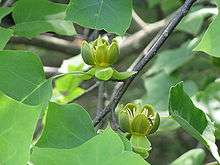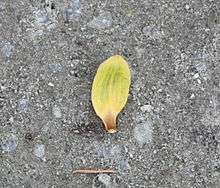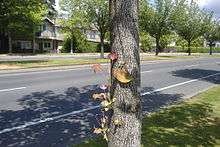Liriodendron chinense
| Chinese Tulip Tree | |
|---|---|
 | |
| Scientific classification | |
| Kingdom: | Plantae |
| (unranked): | Angiosperms |
| (unranked): | Magnoliids |
| Order: | Magnoliales |
| Family: | Magnoliaceae |
| Genus: | Liriodendron |
| Species: | L. chinense |
| Binomial name | |
| Liriodendron chinense (Hemsl.) Sarg. | |
Liriodendron chinense, the Chinese tulip poplar[1] or Chinese tulip tree, is Asia's native species in the Liriodendron genus. This native of central and southern China grows in the provinces of Anhui, Guangxi, Jiangsu, Fujian, Guizhou, Hubei, Hunan, Jiangxi, Shaanxi, Zhejiang, Sichuan and Yunnan, and also locally in northern Vietnam. Protected populations occur in the Tianmushan National Reserve, Huangshan, Wuyi Shan, and Badagongshan Nature Reserve.



Description
Liriodendron chinense is very similar to the American species, Liriodendron tulipifera, differing in the often slightly larger and more deeply lobed leaves, and in the shorter inner petals in the flowers, which lack the orange pigment of L. tulipifera. The Chinese tulip tree reaches about 40 metres (130 ft) tall.[2]
Cultivation
It is not as hardy as the American species, but is cultivated on other continents as an ornamental tree. It is grown in England (where there are many at Kew Gardens [3]), Ireland, Belgium, the Netherlands, and Germany. In North America, it grows as far north as Boston, Massachusetts in the east, and Vancouver, British Columbia in the west. It is a street tree at the University of Victoria and along the Veterans' Memorial Parkway in Langford, British Columbia. In cultivation it grows as fast as the American tulip tree. A cultivar (J.C.Raulston) with leaves larger and darker than typical has been developed in North Carolina.[4]
References
- ↑ Carolinian Forest Garden, UBC Botanical Garden, retrieved 3 February 2016
- ↑ Xia Nianhe, Liu Yuhu, Liu Yuhu & Hans P. Nooteboom. "Liriodendron chinense". Flora of China. Missouri Botanical Garden, St. Louis, MO & Harvard University Herbaria, Cambridge, MA. Retrieved 25 May 2012.
- ↑ Kew Gardens site on tulip trees
- ↑ http://jcra.ncsu.edu/resources/photographs/plants-results.php?serial=110930
- Hunt, D. (ed). 1998. Magnolias and their allies. International Dendrology Society & Magnolia Society. (ISBN 0-9517234-8-0)
